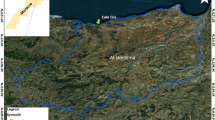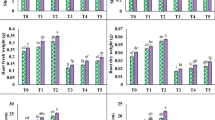Abstract
Natural phenolic compounds (phenolic acids, flavonoids, tannins, lignans) present in food of plant origin are in the focus of interest due to their prevalence, properties and biological activity. The aim of the presented work was to investigate antioxidant and antigenotoxic effects of the anthocyanin-rich extract from red cabbage leaves (Brassica oleracea rubrum) on the changes induced by toxic Cu2+ concentrations. MeOH extract from red cabbage containing anthocyanin (ATH) and phenolic acid derivatives exhibited strong antioxidant properties. Cu2+ decreased mitotic index (MI) and inhibited proliferative activity of Vicia faba root meristematic cells. The morphology of mitotic chromosomes was changed; “erosion” and pulverization might result from Cu2+ high-cytotoxicity. Numerous micronuclei, chromatid bridges and lagging/lost chromosomes were found in the meristematic cells of V. faba, which indicate the clastogenic effect of Cu2+. The application of the ATH-rich extract lowered the number of disturbances induced by Cu2+. The positive role of the ATH-rich red cabbage extract will be discussed.






Similar content being viewed by others
Abbreviations
- ATH:
-
Anthocyanins
- DM:
-
Extract dry matter
- FRAP:
-
Ferric reducing ability of plazma
- FW:
-
Fresh weight
- MI:
-
Mitotic index
- MN:
-
Miconuclei
- PhC:
-
Phenolic compounds
- ROS:
-
Reactive oxygen species
- TE:
-
Trolox equivalents
- TAC:
-
Total antioxidant capacity
References
Aherne SA, O’Brian NM (2000) Mechanism of protection by the flavonoids, quercetin and rutin, against tert-butyl-hydroperoxide and menadione-induced DNA single strand breaks in CACO-2 cells. Free Radic Biol Med 29:507–514
Apel K, Hirt H (2004) Reactive oxygen species: metabolism, oxidative stress and signal transduction. Annu Rev Plant Biol 55:373–399
Bartosz G (2003) Total antioxidant capacity. Adv Clin Chem 37:219–292
Baryla A, Laborde C, Montillet J-L, Triantaphylides C, Chagvardieff P (2000) Evaluation of lipid peroxidation as a toxicity bioassay for plant exposed to copper. Environ Pollut 109:131–135
Benzi IFF, Strain JJ (1996) The ferric reducing ability of plasma (FRAP) as a measure of “antioxidant power”: the FRAP assay. Anal Biochem 239:70–76
Chen EL, Chen YA, Chen LM, Liu ZH (2002) Effect copper on peroxidase activity and lignin content in Raphanus sativus. Plant Physiol Biochem 40:439–444
Dhawan A, Anderson D, De Pascual-Teresa S, Santos-Buelga C, Clifford MN, Ioannides C (2002) Evaluation of the antigenotoxic potential of monomeric and dimeric flavanols, and black tea polyphenols against heterocyclic amine-induced DNA damage in human lymphocytes using the comet assay. Mutat Res 515:39–59
Du Y, Guo H, Lou H (2007) Grape seed polyphenols protect cardiac cells from apoptosis via induction of endogenous antioxidant enzymes. J Agric Food Chem 55:1695–1701
Dyrby M, Westergaard N, Stapelfeldt H (2001) Light and heat sensitivity of red cabbage extract in soft drink model system. Food Chem 72:431–437
Einbond LS, Reynertson KA, Luo X-D, Basile MJ, Kennelly EJ (2004) Anthocyanin antioxidants from edible fruits. Food Chem 84:23–28
Fabre N, Urizzi P, Souchard JP, Ferchard A, Claparols C, Fouraste I, Moulis C (2000) An antioxidant synapic acid ester isolated from Iberis amara. Fitoterapia 71:425–428
Ferguson LR (2001) Role of plant polyphenols in genomic stability. Mutat Res 475:89–111
Fernandes JC, Henriques FS (1991) Biochemical, physiological, and structural effects of excess copper in plants. Bot Rev 57:246–273
Fernandez MT, Mira ML, Florencia MH, Jennings KR (2002) Iron and copper chelation by flavonoids: an electrospray mass spectrometry study. J Inorg Biochem 92:105–111
Garcia-Alonso M, Pascual-Teresa S, Santos-Buelga C, Rivas-Gonzalo JC (2004) Evaluation of the antioxidant properties of fruits. Food Chem 84:13–18
Gąsiorowski K, Szyba K, Brokos B, Kołaczyńska B, Jankowiak-Włodarczyk M, Oszmianski J (1997) Antimutagenic activity of anthocyanins isolated from Aronia melanocarpa fruits. Cancer Lett 119:37–46
Glińska S, Bartczak M, Oleksiak S, Wolska A, Gabara B, Posmyk MM, Janas KM (2007) Effects of anthocyanin-rich extract from red cabbage leaves on meristematic cells of Allium cepa L. roots treated with heavy metals. Ecotoxicol Environ Saf 68:343–350
Grace SG (2005) Phenolics as antioxidants. In: Smirnoff N (ed) Antioxidants and reactive oxygen species. Blackwell, Oxford, pp 141–168
Hale KL, Tufan HA, Pickering IJ, George GN, Terry N, Pilon M, Pilon-Smits EAH (2002) Anthocyanins facilitate tungsten accumulation in Brassica. Physiol Plant 116:351–358
Harper FA, Smith SE, Macnair MR (1997) Where is the cost of copper tolerance in Mimulus guttatus? Testing the trade-off hypothesis. Funct Ecol 11:764–774
Havsteen BH (2002) The biochemistry and medical significance of the flavonoids. Pharmacol Ther 96:67–202
Ivanova D, Gerova D, Chervenkov T, Yankova T (2005) Polyphenols and antioxidant capacity of Bulgarian medicinal plants. J Ethnopharmacol 96:145–150
Jiang W, Liu D, Liu X (2001) Effects of copper on root growth, cell division, and nucleolus of Zea mays. Biol Plant 44:105–109
Jouili H, El Feriani E (2003) Changes in antioxidant and lignifying enzyme activities in sunflower roots (Helianthus annuus L.) stressed with copper excess. Compt Rend Biol 326:639–644
Kasprzak KS (2002) Oxidative DNA and protein damage in metal-induced toxicity and carcinogenesis. Free Rad Biol Med 32:958–967
Katalinic V, Milos M, Kulisic T, Jukic M (2006) Screening of 70 medicinal plant extracts for antioxidant capacity and total phenols. Food Chem 94:550–557
Kontek R, Osiecka R, Kontek B (2007) Clastogenic and mitodepressive effects of the insecticide dichlorvos on root meristems of Vicia faba. J Appl Genet 48:359–361
Langley-Evans SC (2000) Antioxidant potential of green and black tea determined using the ferric reducing power (FRAP) assay. Int J Food Sci Nutr 51:181–188
Lazze MC, Pizzala R, Savio M, Stivala LA, Prosperi E, Bianchi L (2003) Anthocyanins protect against DNA damage induced by tert-butyl-hydroperoxide in rat smooth muscle and hepatoma cells. Mutat Res 535:103–115
Lee SE, Hyun JH, Ha J-S, Jeong HS, Kim JH (2003) Screening of medicinal plant extracts for antioxidant activity. Life Sci 73:167–179
Lombardii L, Sebastiani L (2005) Copper toxicity in Prunus cerasifera: growth and antioxidant enzymes responses of in vitro grown plant. Plant Sci 168:797–802
Lopes GKB, Schulman HM, Hermes-Lima M (1999) Polyphenol tannic acid inhibits hydroxyl radical formation from Fenton reaction by complexing ferrous ions. Biochem Biophys Acta 1472:142–152
Ma TH, Xu Z, Xu C, McConnell H, Rabago EV, Arreola GA, Zhang H (1995) The improved Allium/Vicia root tip micronucleus assay for clastogenicity of environmental pollutans. Mutat Res 334:185–195
Majer BJ, Tscherko D, Paschke A, Wennrich R, Kundi M, Kandeler E, Knasműller S (2002) Effects of heavy metal contamination of soils on micronucleus induction in Tradescantia and on microbial enzyme activities: a comparative investigation. Mutat Res 515:111–124
Maksymiec W (2007) Signalling responses in plants to heavy metal stress. Acta Physiol Plant 29:177–187
Maksymiec W, Krupa Z (2006) The effects of short-term exposition to Cd, excess Cu ions and jasmonate on oxidative stress appearing in Arabidopsis thaliana. Environ Exp Bot 57:187–194
Mazza G, Miniati E (1993) Anthocyanins in fruits, vegetables, and grains. CRC Press, Boka Ranton, pp 283–288
Meharg AA (1994) Integrated tolerance mechanisms-constitutive and adaptative plant-responses to elevated metal concentrations in the environment. Plant Cell Environ 17:989–993
Michalak A (2006) Phenolic compounds and their antioxidant activity in plants growing under heavy metal stress. Pol J Environ Stud 15:523–530
Montoro P, Braca A, Pizza C, De Tommasi N (2004) Structure-antioxidant activity relationships of flavonoids isolated from different plant species. Food Chem 92:349–3554
Moure A, Cruz JM, Franco D, Domίniquez JM, Sineiro J, Domίniquez H, Núñez MJ, Parajó JC (2001) Natural antioxidants from residual sources. Food Chem 72:145–171
Műller WU, Streffer C (1994) Micronucleus assays. Adv Mutagen Res 5:1–134
Neil SJ, Desikan R, Clarke A, Hurst RD, Hancock JT (2002) Hydrogen peroxide and nitric oxide as signalling molecules in plants. J Exp Bot 53(372):1237–1247
Oszmiański J, Wojdylo A (2005) Aronia melanocarpa phenolics and their antioxidant activity. Eur Food Res Technol 221:809–813
Podsędek A, Sosnowska D, Redzynia M, Anders B (2006) Antioxidant capacity and kontent of Brasica oleracea dietary antioxidants. Int J Food Sci Technol 41:49–58
Posmyk MM, Dobranowska A, Janas KM (2005) Role of anthocyanins in red cabbage seedlings response to copper stress. Ecol Chem Eng 12:1107–1112
Posmyk MM, Kontek R, Janas KM (2007) Effect of anthocyanin-rich red cabbage extract on cytological injury induced by copper stress in plant and animal tissues. Environ Prot Nat Source 33:50–56
Priori RL, Wu X (2006) Anthocyanins: structural characteristic that result in unique metabolic patterns and biological activities. Free Rad Res 40:1014–1028
Scalzo RL, Genna A, Branca F, Chedin M, Chassaigne H (2008) Anthocyanin composition of cauliflower (Brassica oleracea L. var. botrytis) and cabbage (B. oleracea L. var. capitata) and its stability in relation to thermal treatments. Food Chem 107:136–144
Schützendübel A, Polle A (2002) Plant responses to abiotic stresses: heavy metal-induced oxidative stress and protection by mycorrhization. J Exp Bot 53:1351–1365
Ślesak I, Libik M, Karpinska M, Karpiński S, Mieszalski Z (2007) The role of hydrogen peroxide in regulation of plant metabolizm and cellular signalling in response to environmental stresses. Acta Biochim Pol 54:39–50
Steyn WJ, Wand JE, Holcroft DM, Jacobs G (2002) Anthocyanins in vegetative tissues: a proposed unfied function in photoprotection. New Phytol 155:349–361
Stintzing FC, Stintzing AS, Carle R, Frei B, Wrolstad RE (2002) Color and antioxidant properties of cyanidin-based anthocyanin pigments. J Agric Food Chem 50:6172–6181
Taylor LP, Grotewold E (2005) Flavonoids as developmental regulators. Curr Opin Plant Biol 8:317–323
Teisseire H, Guy V (2000) Copper-induced changes in antioxidant enzymes activities in fronds of duckweed (Lemna minor). Plant Sci 153:65–72
Tewari R, Kumar P, Sharma PN (2006) Antioxidant responses to enhanced generation of superoxide anion radical and hydrogen peroxide in the copper-stressed mulberry plants. Planta 223:1145–1153
Tsai P-J, McInstosh J, Pearce P, Camden B, Jordan BR (2002) Anthocyanin and antioxidant capacity in Roselle (Hibiscus sabdariffa L.) extract. Food Res Intern 35:351–356
Wang SY, Lin HS (2000) Antioxidant activity in fruits and leaves of blackberry, raspberry and strawberry varies with cultivar and developmental stage. J Agric Food Chem 48:140–146
Wang H, Cao G, Prior RL (1997) Oxygen radical absorbing capacity of anthocyanins. J Agric Food Chem 45:302–309
Wu X, Prior RL (2005) Identification and characterisation of anthocyanins by HPLC-electrospray ionization-tandem mass spectrometry in common foods in the United States: vegetables, nuts and grains. J Agric Food Chem 53:3101–3113
Wu L, Hsu H, Chen Y, Chiu Ch, Lin Y, Ho J (2006) Antioxidant and antiproliferative activities of red pitaya. Food Chem 95:319–327
Xiong Z-T, Liu C, Geng B (2006) Phytotoxic effects of copper on nitrogen metabolism and plant growth in Brasica pekinensis Rupr. Ecotoxicol Environ Saf 64:273–280
Yi H, Si L (2007) Vicia root-mirconucleus and sister chromatid exchange assays on the genotoxicity of selenium compounds. Mutat Res 630:92–96
Yruela I (2005) Copper in plants. Braz J Plant Physiol 17:145–156
Zhang Z, Che W, Liang Y, Wu M, Li N, Shu Y, Liu F, Wu D (2007) Comparison of cytotoxicity and genotoxicity induced by the extracts of methanol and gasoline engine exhausts. Toxicol In Vitro 21:1058–1065
Acknowledgments
This research was supported by State Committee for Scientific Research, grant 2PO4G 044 26 in years 2004–06.
Author information
Authors and Affiliations
Corresponding author
Additional information
Communicated by S. Lewak.
Rights and permissions
About this article
Cite this article
Posmyk, M.M., Kontek, R. & Janas, K.M. Red cabbage extract limits copper stress injury in meristematic cells of Vicia faba . Acta Physiol Plant 30, 481–491 (2008). https://doi.org/10.1007/s11738-008-0145-7
Received:
Revised:
Accepted:
Published:
Issue Date:
DOI: https://doi.org/10.1007/s11738-008-0145-7




